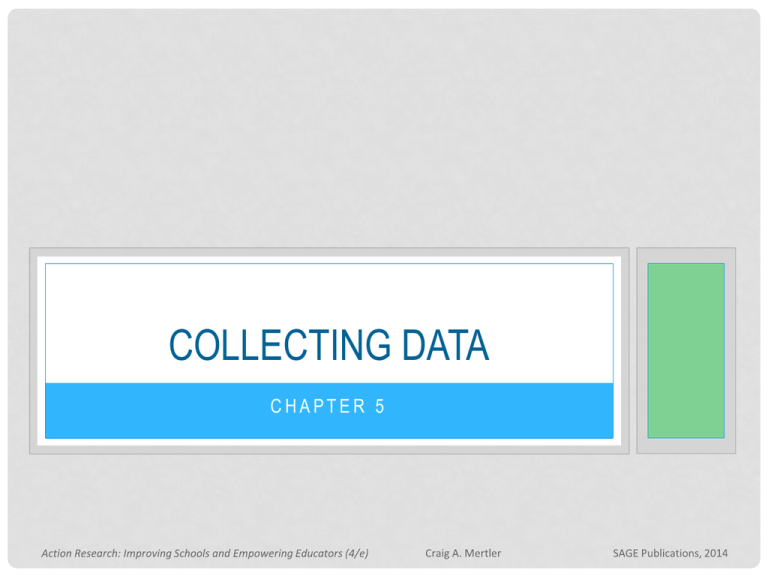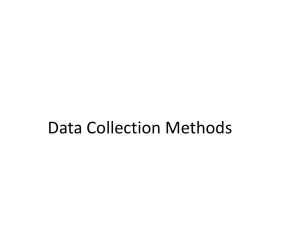Collecting data - Sage Publications
advertisement

COLLECTING DATA CHAPTER 5 QUALITATIVE DATA COLLECTION TECHNIQUES • Qualitative data are narrative • Variety of techniques: • Observations—carefully watching and systematically recording what you see and hear • Structured observations • Semi-structured observations • Unstructured observations • Recorded using field notes, videotapes • Should include observer’s comments in the field notes QUALITATIVE DATA COLLECTION TECHNIQUES • Interviews—directly asking people questions (as opposed to watching them); conversations between teacher-researcher and participants • Prepare an interview guide (may be specific or general) • Several types: • Structured interviews • Semi-structured interviews • Unstructured (open-ended) interviews • Focus group • Informal (spontaneous) interviews QUALITATIVE DATA COLLECTION TECHNIQUES • Journals—means of gathering data to provide insight into workings of a classroom • Types of data journals: • Student journals • Teacher journals • Class journals • Existing documents and records—schools are filled with existing sources of data • Classroom artifacts—classrooms are, too! • Reflective teaching—diagnosing areas in need of improvement QUALITATIVE DATA COLLECTION TECHNIQUES • Quality of qualitative data • Validity of research data—extent to which data collected accurately measure what they purport to measure • Validity of qualitative data: concern lies with trustworthiness of data; must examine: • Credibility—must establish that results are believable from perspective of a participant • Dependability—must ensure that research responded to ever-changing context of the study QUALITATIVE DATA COLLECTION TECHNIQUES • Quality of qualitative data (cont’d.) • Trustworthiness of data is enhanced through: • Triangulation—use of multiple data sources, multiple data-collection methods, and multiple teacher-researchers (if possible) • Member checking—sharing data and analyses with participants to check for accuracy • Prolonged engagement and persistent observation—more time spent “in the field,” more you get to know participants, culture, behaviors, etc. QUANTITATIVE DATA COLLECTION TECHNIQUES • Quantitative data are numerical • Variety of techniques: • Surveys, questionnaires, rating scales—verbal or written administration of set of questions or statements to sample of people • Open-ended questions or closed-response rating scales • Likert and Likert-type scales • Checklists • Follow guidelines and suggestions for developing instruments • Web-based data collection • SurveyMonkey, Checkbox, Zoomerang, Poll Everywhere, others QUANTITATIVE DATA COLLECTION TECHNIQUES • Variety of techniques (cont’d.): • Formative and summative classroom assessments • Formative—administered during instruction; used to determine what sort of adjustments should be made to instruction (while it is still going on) • Summative—administered following instruction; used for more administrative decision making • Standardized tests (and other formal instruments) • Although typically no one’s favorite—can serve as important additional source of data QUANTITATIVE DATA COLLECTION TECHNIQUES • Quality of quantitative data • Validity—extent to which you actually measured what you intended to measure • Must be appropriate and accurate for your purposes • Seen as a unitary concept, combining content, concurrent, predictive, and construct validity (focus should be on evidence based on instrument content) • Reliability—refers to consistency of collected data • Determined statistically QUANTITATIVE DATA COLLECTION TECHNIQUES • Quality of quantitative data (cont’d.) • Reliability • Determined by correlating results with themselves or with another quantitative measure • Three methods: • Test-retest reliability • Equivalent forms reliability Not appropriate for teachers; requires two administrations of instrument (not practical in classrooms) • Internal consistency reliability • KR-21 formula (uses mean, SD, number of items) • “A valid test is always reliable, but a reliable test is not always valid.” ETHICS AND DATA COLLECTION • Must obtain permission—especially if data collection is outside of normal, routine activities that occur in a classroom or school • From students, parents, and others you might collect data from • Requirement for seeking formal permission can also be guided by potential audience of action research • Data must be kept secure and confidential DATA COLLECTION TEMPLATE • Planning for Data Collection Planning for Data Collection 1. The topic I’m thinking of doing action research on is… 2. My research question is… 3. Important demographic variables (if any) include… 4. The instrumentation needed to answer my research question can be described as… 5. The following must be included in my data collection in order to answer my question… 6. Other data collection concerns I have include… Reme mber… A ll a s p e c t s o f y o ur s tu d y a nd i ts d e s i g n m us t b e P A R A L L E L ! ! ACTION RESEARCH CHECKLIST 5 ☐ ☐ ☐ ☐ ☐ Action Research Checklist 5: Developing a Data Collection Plan for Action Research Revisit your research question(s) and your previous decisions about whether you will use a qualitative, quantitative, or mixedmethods design for your action research. If you intend to collect qualitative data, decide which of the following you will use: ☐ Observations (structured, semi-structured, or unstructured?) ☐ Interviews (structured, semi-structured, or unstructured?) ☐ Journals ☐ Existing documents ☐ Other sources of qualitative data? If you intend to collect quantitative data, decide which of the following you will use: ☐ Surveys, questionnaires, or rating scales (what types of scales—Likert, Likert-type, or other—or open-ended questions?) ☐ Checklists ☐ Formative and/or summative classroom assessments ☐ Standardized test scores ☐ Existing numerical data ☐ Other sources of quantitative data? If you intend to use anything original (i.e., self-developed) such as interview guides, surveys, or formative assessments, develop drafts of your data collection instrumentation. Engage in appropriate processes (depending on the type of data collection instrument you are using) to ensure that you will collect good, quality data.











